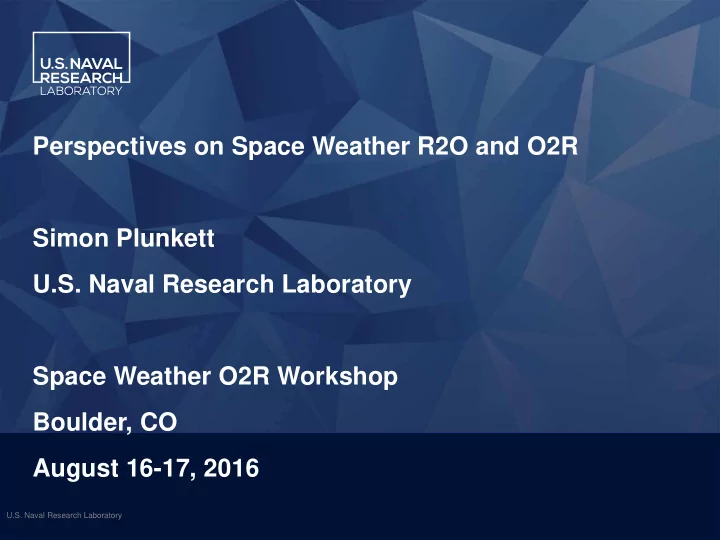

Perspectives on Space Weather R2O and O2R Simon Plunkett U.S. Naval Research Laboratory Space Weather O2R Workshop Boulder, CO August 16-17, 2016 U.S. Naval Research Laboratory
Solar Coronagraphs: An Example of R2O (and O2R) • Accurate, reliable and timely warning of potential CME impact at Earth is critical for protection of space assets and space situational awareness. • DoD and civilian space weather forecasters currently rely on research sensors with limited lifetime for notification of potentially geoeffective CMEs. • A coronagraph can provide advance notice of CME arrival with a lead time of 1 – 4 days and an expected accuracy of about ± 6 hours. • NRL developed the LASCO coronagraphs that have operated on the ESA/NASA SOHO mission since 1996. • LASCO has detected almost all significant geoeffective CMEs during solar cycles 23 and 24. • SOHO is now well beyond its design life. • SOHO transitioned to the “Bogart” mission in 2010, with the principal purpose of continuing to provide Earth-Sun line coronagraph imagery. • NOAA plans to fly an operational coronagraph on the Space Weather Follow-On mission in ~2020. U.S. Naval Research Laboratory Plunkett – O2R Workshop | 2
GPS and Ionosonde Ground Stations Global Assimilation of Ionospheric Measurements Ionospheric Space Weather Global Distribution of Ionospheric Plasma GAIM GAIM assimilates observations of slant total electron DMSP SSULI content (TEC) from GPS ground receiver sites, SSUSI bottomside electron density profiles from SSIES ionosondes, in-situ electron density, ultraviolet limb and disk observations from Defense Meteorological Satellite Program (DMSP) satellites, and GPS radio occultations from COSMIC satellites. The model provides specifications and forecasts of 3D electron density distributions.
The DoD Operational GAIM Program Global Assimilation of Ionospheric Measurements SMC NRL AFRL Program Technical Model Management Direction Validation ACC 557 th Weather Wing GDAS SWAFS USU DoD Users (NG) GAIM GAIM Software Ionosphere Products Space Environment Data Providers NRL APL AFRL USAF JPL UCAR Space Environment Data and NRL Ionosphere Product Archive SWAFS – Space Weather Analysis and Forecast System GDAS – Ground Data Analysis Software
Some Issues Facing SWx O2R • Cultural differences • Research community asks how and why? • Operational community asks what, when, and where? • Dedicated liaisons between research and operational communities could help to mitigate these differences. • Research tends to focus on big events, operations just as concerned with day-to- day variability • Ability to make accurate, reliable, all-clear forecasts just as important as predicting extreme events. • Lack of feedback from O2R • What does the operational community do now? • What are the capability gaps or knowledge gaps? • What research is needed to fill the gaps? • Lack of funding for O2R • Research funding stops when basic understanding is achieved (publish papers, write grant report, kick start R2O transition, move on to the next topic …) • Operational data and models not easily accessible for research • Research tools and methods rapidly get out of sync with operations • No single agency or organization has authority and responsibility for O2R U.S. Naval Research Laboratory Plunkett – O2R Workshop | 5
Solution Ideas • Establish an interagency body (physical or virtual) with the authority and responsibility for SWx O2R • Director should come from the operational community • Input from both research and operational communities • Dedicated source of funding for O2R grants/contracts • Researcher access to operational tools • Liaison officers in operational centers • Regular cadence of proposal opportunities based on operational needs • Needs/requirements must be feasible given current state of research • Focused research with defined products ready for operational evaluation in ~ 1 year • Test products to quantify improvement • Rapid transition from R2O for products that work to fill capability gaps • Increase focus on O2R in SWx education • Need to educate both research and operational communities • Heliophysics Summer Schools • Jack Eddy Postdoctoral Fellowships U.S. Naval Research Laboratory Plunkett – O2R Workshop | 6
Acquisitions: A Systems Engineering Approach U.S. Naval Research Laboratory Plunkett – O2R Workshop | 7
Spiral Development Model Kossiakoff et al. (2011) U.S. Naval Research Laboratory Plunkett – O2R Workshop | 8
Summary • NRL has experience with R2O and O2R in instrumentation, data products, and models. • Continue to work with both civilian and DoD operational communities to enable R2O and O2R processes. • Effective R2O and O2R requires commitment from both operational and research communities. • Hurdles exist, both cultural and practical, but these can be overcome. • DoD approach to acquisitions and systems engineering of large, complex systems may offer some lesson learned for the space weather community. U.S. Naval Research Laboratory Plunkett – O2R Workshop | 9
Acknwledgement This work was supported by the Chief of Naval Research. U.S. Naval Research Laboratory Plunkett – O2R Workshop | 10
Recommend
More recommend